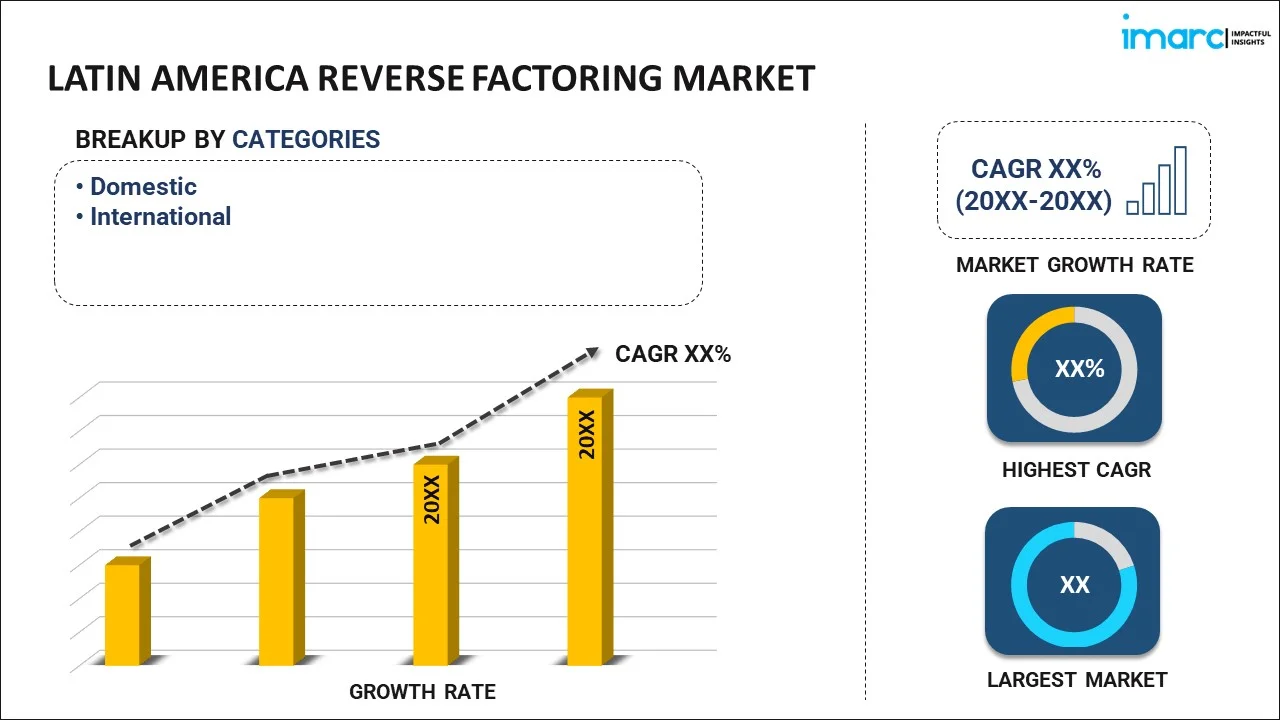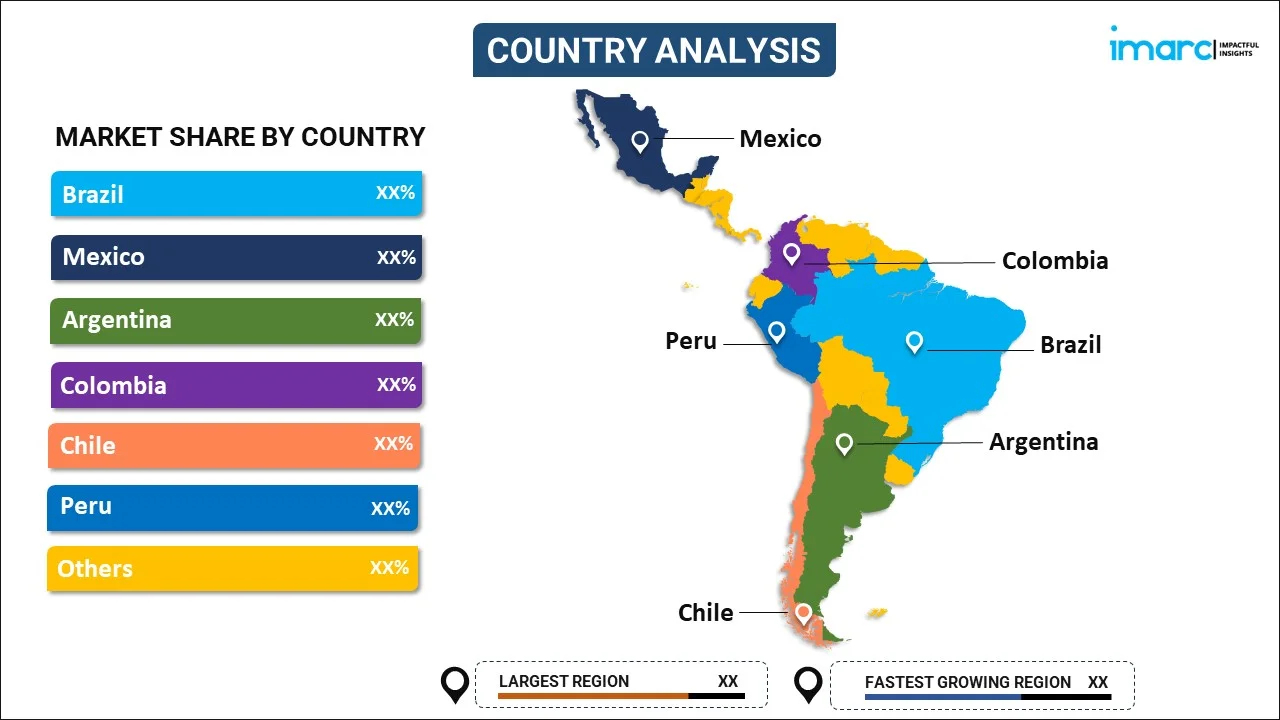
Latin America Reverse Factoring Market Report by Category (Domestic, International), Financial Institution (Banks, Non-Banking Financial Institutions), End Use (Manufacturing, Transport and Logistics, Information Technology, Healthcare, Construction, and Others), and Country 2025-2033
Market Overview:
Latin America reverse factoring market size reached USD 47.1 Billion in 2024. Looking forward, IMARC Group expects the market to reach USD 204.6 Billion by 2033, exhibiting a growth rate (CAGR) of 16.4% during 2025-2033. The rising demand for digital platforms and automation tools, which streamline the process, thereby reducing paperwork and increasing the speed of transactions, is primarily driving the regional market.
|
Report Attribute
|
Key Statistics
|
|---|---|
|
Base Year
|
2024
|
|
Forecast Years
|
2025-2033
|
|
Historical Years
|
2019-2024
|
|
Market Size in 2024
|
USD 47.1 Billion |
|
Market Forecast in 2033
|
USD 204.6 Billion |
| Market Growth Rate 2025-2033 | 16.4% |
Reverse factoring, also known as supply chain finance, is a financial arrangement that involves a third-party financing institution to help companies manage their payables. In this process, the buyer of goods or services arranges with a financial institution to pay its suppliers on behalf of the buyer. The suppliers, in turn, receive early payment for their invoices, improving their cash flow. The financial institution earns a fee for facilitating the transaction. Unlike traditional factoring, where the focus is on receivables, reverse factoring concentrates on the payable side of the equation. This method enhances working capital efficiency for both buyers and suppliers, fostering stronger relationships within the supply chain. It's a strategic financial tool that enables companies to optimize their cash flow and strengthen their supplier relationships by offering timely payment solutions.
Latin America Reverse Factoring Market Trends:
The reverse factoring market in Latin America has witnessed a surge in popularity in recent years, driven by several key market drivers. Firstly, companies across industries are increasingly recognizing the importance of optimizing working capital management. In this context, reverse factoring offers a strategic solution by allowing suppliers to receive early payments against their invoices, thereby enhancing their liquidity and minimizing financial stress. Additionally, the growing complexity of regional supply chains has propelled the demand for more efficient financing options. Reverse factoring, with its ability to streamline payment processes and mitigate risks, has emerged as a preferred choice for both buyers and suppliers navigating intricate supply chain networks. Furthermore, technological advancements play a pivotal role in propelling the reverse factoring market forward. The integration of digital platforms and fintech solutions has facilitated smoother and faster transaction processes, making reverse factoring an attractive proposition for businesses seeking agility and transparency in their financial operations. Moreover, the heightened focus on sustainable business practices has driven companies to adopt supply chain finance as a means to strengthen relationships with suppliers, promoting ethical and responsible business conduct. In conclusion, the confluence of working capital optimization, supply chain complexity, technological innovation, and sustainability goals collectively propels the reverse factoring market in Latin America, positioning it as a crucial component of modern financial strategies.
Latin America Reverse Factoring Market Segmentation:
IMARC Group provides an analysis of the key trends in each segment of the market, along with forecasts at the regional and country levels for 2025-2033. Our report has categorized the market based on category, financial institution, and end use.
Category Insights:

- Domestic
- International
The report has provided a detailed breakup and analysis of the market based on the category. This includes domestic and international.
Financial Institution Insights:
- Banks
- Non-Banking Financial Institutions
A detailed breakup and analysis of the market based on the financial institution have also been provided in the report. This includes banks and non-banking financial institutions.
End Use Insights:
- Manufacturing
- Transport and Logistics
- Information Technology
- Healthcare
- Construction
- Others
The report has provided a detailed breakup and analysis of the market based on the end-use. This includes manufacturing, transport and logistics, information technology, healthcare, construction, and others.
Country Insights:

- Brazil
- Mexico
- Argentina
- Colombia
- Chile
- Peru
- Others
The report has also provided a comprehensive analysis of all the major regional markets, which include Brazil, Mexico, Argentina, Colombia, Chile, Peru, and Others.
Competitive Landscape:
The market research report has also provided a comprehensive analysis of the competitive landscape. Competitive analysis such as market structure, key player positioning, top winning strategies, competitive dashboard, and company evaluation quadrant has been covered in the report. Also, detailed profiles of all major companies have been provided.
Latin America Reverse Factoring Market Report Coverage:
| Report Features | Details |
|---|---|
| Base Year of the Analysis | 2024 |
| Historical Period | 2019-2024 |
| Forecast Period | 2025-2033 |
| Units | Billion USD |
| Scope of the Report | Exploration of Historical Trends and Market Outlook, Industry Catalysts and Challenges, Segment-Wise Historical and Future Market Assessment:
|
| Categories Covered | Domestic, International |
| Financial Institutions Covered | Banks, Non-Banking Financial Institutions |
| End Uses Covered | Manufacturing, Transport and Logistics, Information Technology, Healthcare, Construction, Others |
| Countries Covered | Brazil, Mexico, Argentina, Colombia, Chile, Peru, Others |
| Customization Scope | 10% Free Customization |
| Post-Sale Analyst Support | 10-12 Weeks |
| Delivery Format | PDF and Excel through Email (We can also provide the editable version of the report in PPT/Word format on special request) |
Key Questions Answered in This Report:
- How has the Latin America reverse factoring market performed so far and how will it perform in the coming years?
- What has been the impact of COVID-19 on the Latin America reverse factoring market?
- What is the breakup of the Latin America reverse factoring market on the basis of category?
- What is the breakup of the Latin America reverse factoring market on the basis of financial institution?
- What is the breakup of the Latin America reverse factoring market on the basis of end use?
- What are the various stages in the value chain of the Latin America reverse factoring market?
- What are the key driving factors and challenges in the Latin America reverse factoring?
- What is the structure of the Latin America reverse factoring market and who are the key players?
- What is the degree of competition in the Latin America reverse factoring market?
Key Benefits for Stakeholders:
- IMARC’s industry report offers a comprehensive quantitative analysis of various market segments, historical and current market trends, market forecasts, and dynamics of the Latin America reverse factoring market from 2019-2033.
- The research report provides the latest information on the market drivers, challenges, and opportunities in the Latin America reverse factoring market.
- Porter's five forces analysis assist stakeholders in assessing the impact of new entrants, competitive rivalry, supplier power, buyer power, and the threat of substitution. It helps stakeholders to analyze the level of competition within the Latin America reverse factoring industry and its attractiveness.
- Competitive landscape allows stakeholders to understand their competitive environment and provides an insight into the current positions of key players in the market.
Need more help?
- Speak to our experienced analysts for insights on the current market scenarios.
- Include additional segments and countries to customize the report as per your requirement.
- Gain an unparalleled competitive advantage in your domain by understanding how to utilize the report and positively impacting your operations and revenue.
- For further assistance, please connect with our analysts.
 Inquire Before Buying
Inquire Before Buying
 Speak to an Analyst
Speak to an Analyst
 Request Brochure
Request Brochure
 Request Customization
Request Customization




.webp)




.webp)












